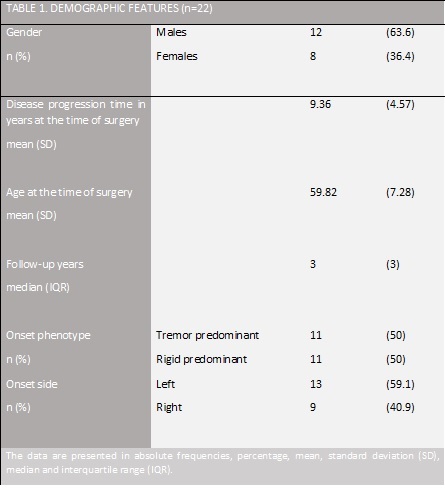Session Information
Date: Wednesday, September 25, 2019
Session Title: Surgical Therapy
Session Time: 1:15pm-2:45pm
Location: Les Muses Terrace, Level 3
Objective: To evaluate the benefits of STN DBS in a sample of Argentines patients with PD.
Background: The treatment with bilateral STN DBS in patients with PD and motor fluctuations has demonstrated being effective to control the motor symptoms with reduction in the dopaminergic medication.1,2
Method: We assessed demographic characteristics and clinical results in 22 patients who were underwent to bilateral STN DBS in a DBS Center in Buenos Aires, Argentina. The variables analysed in pre-surgical period (PRE) and post-surgical follow up (PT) were as follows: ON Levodopa duration in hours, OFF percentage, Schwab and England Scale (S&E), PDQL-37 scale, MDS-UPDRS and Levodopa Equivalent Daily Dose (LEDD). Wilcoxon and T tests were used to comparisons.
Results: The follow-up evaluation (FU) median was 3 years. The demographic features are shown (table 1). The ON levodopa duration median was 2.5 hours in PRE and 3.75 hours in PT (p 0.001). The STN DBS prolonged the ON levodopa period by 50% (1.25hours). The OFF percentage was 65% and 30%, respectively, (p 0.001). 45.5% of the patients had less than 70 points in PRE S&E compared to 18.2% in PT. The PRE PDQL-37 median was 90 and 122 in PT (p 0.22). MDS-UPDRS mean in OFF and ON levodopa state before the surgery was 45.9 and 21.8, respectively, 46.6 in OFF levodopa-OFF DBS, 26.13 in ON levodopa-OFF DBS, 18.59 in OFF levodopa-ON DBS and 18.59 in ON levodopa-ON DBS. The LEDD median in PRE was 1392mg and 891.8mg in PT (35.9% reduction) (p 0.041).
Conclusion: The STN DBS prolonged the ON levodopa period, improved the QoL scales and reduced the LEDD in 3y FU. Given that there wasn’t significant difference between the MDS-UPDRS in OFF state before the surgery and in the follow-up, “disease stability” could be considered. There was not difference in the MDS-UPDRS mean in ON levodopa-ON DBS and OFF levodopa-ON DBS, so the factor that mostly contributed to improvement of the patient was the DBS therapy.
References: 1. Rodriguez-Oroz MC, Obeso JA, Lang AE, Houeto JL, Pollak P, Rehncrona S, et al: Bilateral deep brain stimulation in Parkinson’s disease: a multicentre study with 4 years follow-up. Brain 128 (Pt 10):2240-2249, 2005. 2. Kumar R, Lozano AM, Kim YJ, Hutchison WD, Sime E, Halket E, et al: Double-blind evaluation of subthalamic nucleus deep brain stimulation in advanced Parkinson’s disease. Neurology 51:850-855, 1998.
To cite this abstract in AMA style:
C. Ramirez Gomez, N. Portinari, J. Travi, V. Montilla Uzcategui, F. Micheli, F. Piedimonte. Clinical Results in Argentines Patients with STN DBS in Parkinson’s Disease [abstract]. Mov Disord. 2019; 34 (suppl 2). https://www.mdsabstracts.org/abstract/clinical-results-in-argentines-patients-with-stn-dbs-in-parkinsons-disease/. Accessed April 25, 2025.« Back to 2019 International Congress
MDS Abstracts - https://www.mdsabstracts.org/abstract/clinical-results-in-argentines-patients-with-stn-dbs-in-parkinsons-disease/

